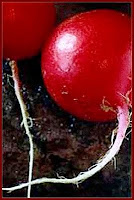Chicken is a staple in many house holds. If you eat chicken once a week for sixty years, you may end up cooking 3120 birds and you may have spent more than 140 days cooking them based on 1 hour per bird. You might as well learn how to do it simply and achieve a PERFECT BIRD where the wing tips crunch like potatoes chip, the skin is a dark brown and crackling crisp, and the whole bird is succulently juicy especially the breast and the whole bird extremely flavorful. The magic of the recipe is the heat of the oven. The bird will cook at 500 F for 1 hour. The potatoes will have absorbed some of the juices of the chicken. This is a meal fit for kings. I rate this recipe with 5 stars! Boy could my mother cook a chicken!
The regime of very high temperature cooking requires being aware that it is rather easy to burn ingredients if they are not suitable to this heat. Do not pepper the bird or the potatoes as the pepper will just burn. Do not substitute margarine for butter as it too will just burn. Do not use a seasoned salt as ingredients in it will also burn.
1 Free range frying chicken (3 ½ ~ 4 ½ pounds)
3~4 Idaho potatoes, peeled and cut into wedge shaped slices not too large
1 Stick of melted unsalted butter
1 Tablespoon olive oil
Salt
Pepper (after the bird is cooked)
Pre-heat the oven to 500o F. (That is not a mistake - 500!)
Wash chicken well and dry it thoroughly inside and out with paper towels. Remove any excess fat from the cavity flaps. If the cavity opening is too closed down, remove some of the flaps with a sharp knife. The cavity opening should be larger than a golf ball to allow heat to enter. This is vital to correct cooking.
Wipe the bottom of a glass roasting pan with olive oil. (Do NOT line the pan with tin foil.) Cover the bottom of the pan with cut up potatoes wedges. Salt these.
Place the whole chicken on top of the potatoes in the center of the pan. Pour the melted butter over the chicken and the potatoes. Salt the chicken. Roast in center oven rack for one hour until the bird is a dark golden brown.
Remove the bird to a platter and arrange the potatoes around it. Using a spoon, pour some of the juices over the the potatoes. Now pepper the bird and the potatoes. Garnish with a few sprigs of rosemary. Serve on the table. Use kitchen shears, a sharp knife and thongs for serving. Let stand 8 minutes before carving.
If you have more guests, double the recipe but for best results, use two pans. You may split the chicken down the breastbone and through the back and cook the haves atop the potatoes wing tip up. Then each serving is a half a chicken per person and no further carving is required.
Don’t mess with the heat although, the first time, you will be tempted to turn the oven down, it would be a mistake. Don’t try to stuff the bird either. You may think that a single 4 pound bird is plenty to go around but everyone will want seconds!














